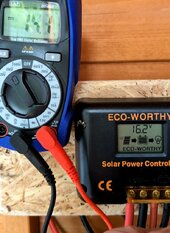MikeintheShed
New Member
Hi,
I have a few questions for the group.
I have a single panel 120w setup for a summerhouse just to power my chargers for a tablet, phone and a rechargeable lamp.
I know it is a "cheap" setup. Eco-worthy, with a 30a Lifepo4. The controller is the standard PWM 30a.
It ran great on a SLA battery but as I added a Lifepo4 and set the controller to Life I get voltage spikes over 16v. This shuts off my speaker so I have put the SLA battery back on to save killing anything.
I see that is seems to be from the BMS shutting off etc.
So to the questions:
Will a new battery solve it or are the BMS all the same?
Advice seems to be lower the voltage, if I do this will it still charge the battery fully? ( I tried it and at 13.5 it still spikes but to 14.6v)
Will the spikes do any damage to the battery or controller and could I let it spike and smooth out the 12v, a capacitor?
Would a MPPT controller control the spikes?
Thanks,
Mike
I have a few questions for the group.
I have a single panel 120w setup for a summerhouse just to power my chargers for a tablet, phone and a rechargeable lamp.
I know it is a "cheap" setup. Eco-worthy, with a 30a Lifepo4. The controller is the standard PWM 30a.
It ran great on a SLA battery but as I added a Lifepo4 and set the controller to Life I get voltage spikes over 16v. This shuts off my speaker so I have put the SLA battery back on to save killing anything.
I see that is seems to be from the BMS shutting off etc.
So to the questions:
Will a new battery solve it or are the BMS all the same?
Advice seems to be lower the voltage, if I do this will it still charge the battery fully? ( I tried it and at 13.5 it still spikes but to 14.6v)
Will the spikes do any damage to the battery or controller and could I let it spike and smooth out the 12v, a capacitor?
Would a MPPT controller control the spikes?
Thanks,
Mike



